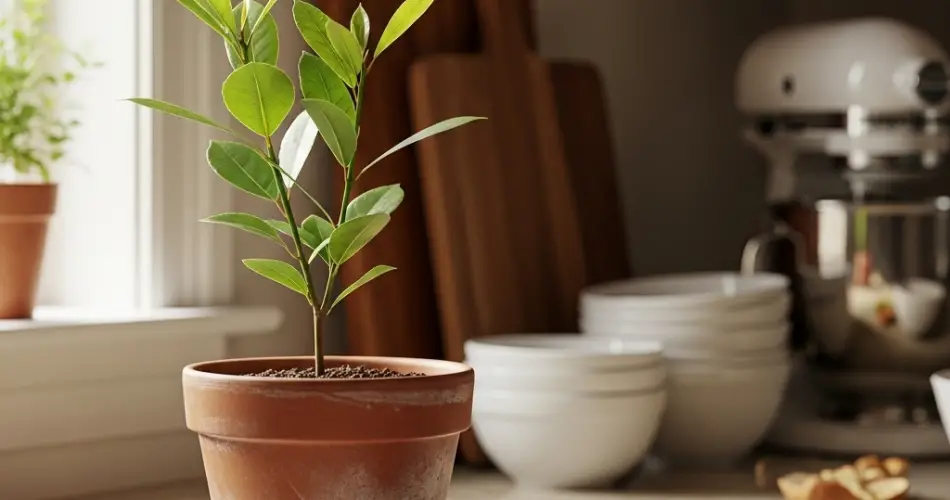Bay leaf (Laurus nobilis) is a timeless culinary herb known for its subtle, aromatic flavor that enhances soups, stews, sauces, and braised dishes. Growing bay leaf indoors or on a small balcony not only ensures a steady supply of fresh leaves but also adds a touch of greenery to your kitchen environment. With careful attention to planting, trimming, and harvesting, even small-space gardeners can enjoy the full benefits of this versatile herb.
Bay leaf plants are evergreen shrubs that develop glossy, dark green leaves and can grow several feet tall over time. Indoors, they tend to remain more compact, making them ideal for containers. Their rich flavor and fragrance make them indispensable in cooking, while their ornamental appeal makes them a decorative addition to your home garden.
Choosing the Right Container
A healthy bay leaf plant starts with the right pot:
-
Drainage: Ensure the container has holes to prevent water accumulation, which can lead to root rot.
-
Size: Start with a medium pot (10–14 inches in diameter). As the plant matures, you may need a larger container to accommodate root growth.
-
Material: Terra-cotta or ceramic pots are preferred because they allow airflow and help maintain balanced soil moisture.
Proper container choice supports healthy root development and steady growth.
Soil Requirements
Bay leaf plants thrive in well-draining soil with a slightly acidic to neutral pH (6.0–7.0). A good indoor soil mix includes:
-
Standard potting soil
-
Sand or perlite to improve drainage
-
Organic compost to provide essential nutrients
Avoid dense, clay-heavy soils, which retain excessive moisture and increase the risk of root disease.
Light and Placement
Bay leaf plants need plenty of light for healthy growth:
-
Natural Light: Place near a south- or west-facing window for 6–8 hours of indirect sunlight daily.
-
Supplemental Lighting: If natural light is insufficient, use a grow light for 10–12 hours daily.
-
Rotation: Turn the plant occasionally to ensure even growth and prevent leaning toward the light source.
Avoid harsh direct sunlight, which can scorch delicate indoor leaves.
Watering and Humidity
Maintaining the right moisture level is key to indoor bay leaf health:
-
Watering: Water when the top 1–2 inches of soil feel dry. The soil should be moist but not waterlogged.
-
Humidity: Bay leaf plants prefer moderate humidity. Mist the leaves occasionally or place a water tray nearby to help maintain moisture, especially in dry indoor environments.
-
Consistency: Avoid sudden changes in watering or humidity, which can stress the plant and cause leaf drop.
Fertilizing Indoor Bay Leaf Plants
During the growing season (spring and summer), light fertilization promotes healthy foliage:
-
Use a balanced, water-soluble fertilizer every 4–6 weeks.
-
Reduce or stop fertilization in fall and winter when growth slows.
-
Organic alternatives such as diluted fish emulsion or compost tea are safe for edible plants.
Avoid over-fertilizing, which can result in excessive leaf growth and reduced flavor quality.
Pruning and Harvesting
Pruning is essential for maintaining a healthy, productive bay leaf plant:
-
Trimming: Remove yellow or damaged leaves to keep the plant looking tidy.
-
Shaping: Light pruning encourages bushier growth and helps maintain a manageable size for indoor spaces.
-
Harvesting: Snip leaves as needed for cooking. Only remove about one-third of the plant at a time to avoid stress.
Regular pruning also improves air circulation through the foliage, reducing the likelihood of pest infestations and disease.
Common Indoor Challenges
Bay leaf plants are relatively low-maintenance but may encounter occasional problems:
-
Leaf Drop: Usually caused by low humidity, irregular watering, or sudden temperature changes.
-
Pests: Spider mites, scale, and aphids can appear. Treat with insecticidal soap or neem oil.
-
Slow Growth: Limited light or nutrient-poor soil can reduce growth. Ensure adequate light and occasional feeding.
Monitoring the plant regularly helps prevent minor issues from becoming major problems.
Cooking with Fresh Bay Leaves
Freshly harvested bay leaves bring a superior aroma and flavor to your dishes compared to dried store-bought leaves. They can be added to:
-
Soups and stews for a subtle, herbal note
-
Braised meats and poultry dishes
-
Sauces, stocks, and marinades
-
Herbal teas, offering a fragrant, soothing infusion
Remember to remove bay leaves before serving, as their rigid texture can be tough to chew.
Final Thoughts
Growing, trimming, and cooking with bay leaf in your kitchen is an enjoyable and rewarding process. With proper attention to container choice, soil, light, water, and pruning, you can maintain a healthy indoor bay leaf plant that provides fresh leaves year-round.
By cultivating your own bay leaf plant, you gain control over flavor, freshness, and quality while adding a beautiful, aromatic herb to your home. Indoor bay leaf gardening combines practicality with aesthetics, creating a lush green companion that enhances both your culinary creations and your living space.



